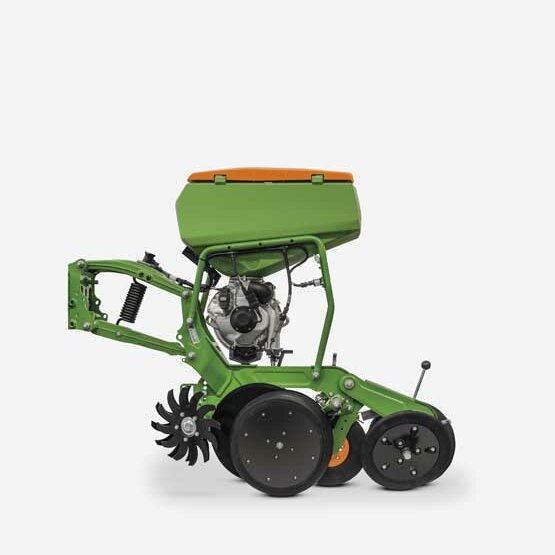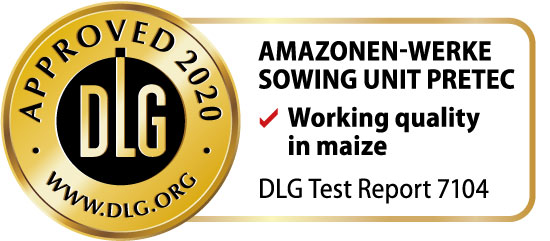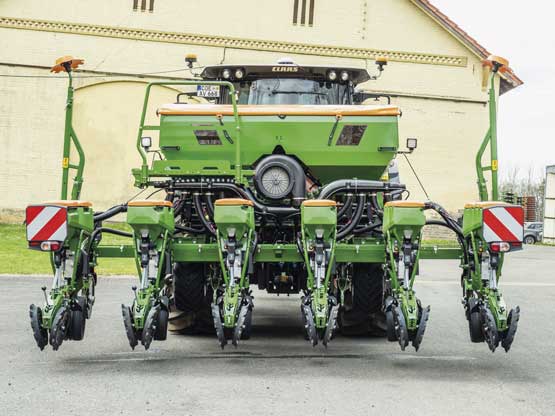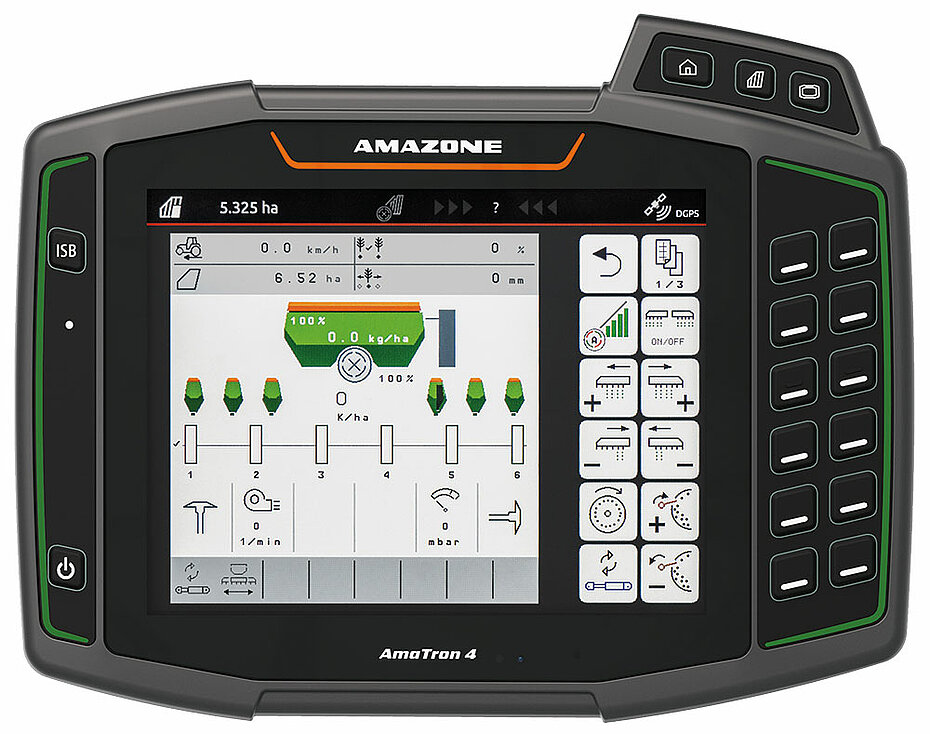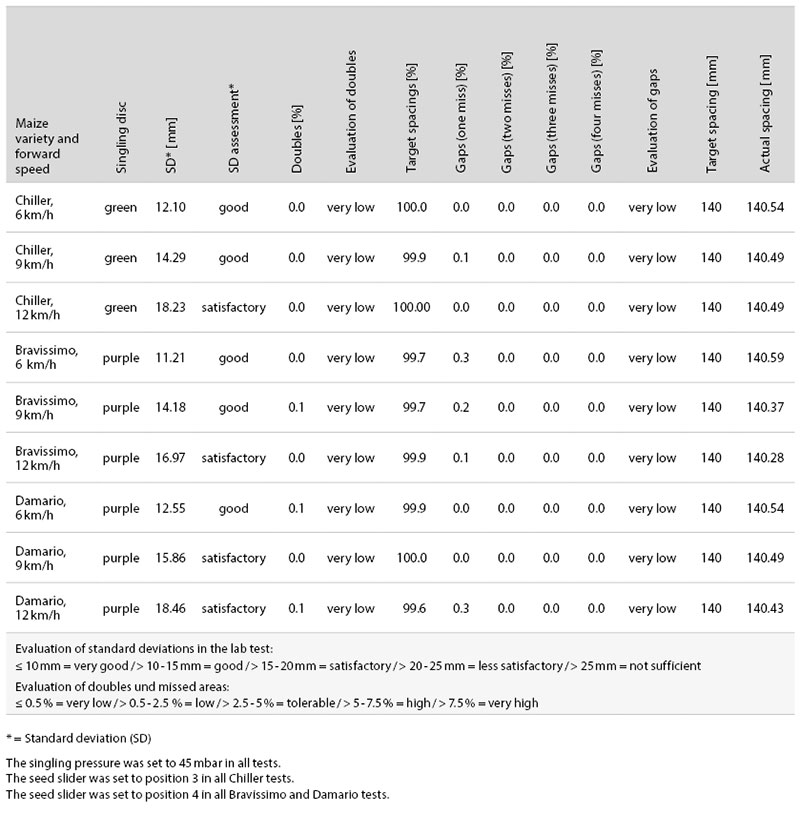Amazone Sowing unit Amazone PreTeC
Working quality in maize
The quality mark
A test mark „DLG-APPROVED for individual criteria“ is awarded for agricultural products which have successfully fulfilled a scope-reduced usability testing conducted by DLG according to independent and recognized evaluation criteria. The test is intended to highlight particular innovations and key criteria of the test object. The test may contain criteria from the DLG test scope for overall tests, or focus on other value-determining characteristics and properties of the test subject. The minimum requirements, test conditions and procedures as well as the evaluation bases of the test results will be specified in consultation with an expert group of DLG. They correspond to the recognized rules of technology, as well as scientific and agricultural knowledge and requirements. The successful testing is concluded with the publication of a test report, as well as the awarding of the test mark which is valid for five years from the date of awarding.
In 2020, the Amazone PreTeC sowing unit was subjected to the DLG partial test on “Working quality in maize”. The test comprised a lab test and a field test. In each test version the unit drilled three maize varieties.
The sowing unit on a 6-row Amazone Precea 4500-2CC Super precision drill was specified with the Precis fertiliser metering and placement system. In the lab test, the distribution of seeds along the rows (accuracy of seed placement and distribution) on the stationary sowing unit was measured and evaluated by simulating forward speeds between 6 km/h and 12 km/h. The field test was carried out on 29 July 2020. The field was flat and the forward speeds ranged between 6 km/h and 12 km/h. The seedbed was described as sufficiently consolidated. The distribution of plants along the rows (accuracy of eventual crop spacing, accuracy of seed distribution) and field emergence were evaluated on 11 August 2020 by using the DLG-owned mobile spacing meter. These measurements were subsequently evaluated statistically.
Apart from these tests, further measurements were taken at forward speeds of 15 km/h, both at the lab and in the field, yet without assessing these results. At 15 km/h the sowing unit produced the minimum quality of work for obtaining the DLG test seal in the field test yet not in the lab test. No further criteria came to the test.
Evaluation in brief
The lab test
In the lab test, the standard deviations that were computed from the seed spacing measurements were found to be “good” and “satisfactory”. The percentages of doubles and gaps were found to be “very low”.
The field test
In the field test, the accuracy of eventual crop spacing was assessed as ‘very good’ in all instances with one exception. Field emergence is always assessed as ‘very good’ in all test variants. This ranged between 94.5 % and 98.0 %, which is identical with the ability to germinate for the crops. The percentages of target spacings were between 93.2 % and 97.5 %. The percentages of double were between 0.3 % and 2.2 %. The percentages of gaps were between 1.9 % and 5.1 %.
The performance of the Amazone PreTeC sowing unit was impressive in the test that was conducted by the criteria laid down in the DLG test framework. Based on these test results, the sowing unit is awarded the DLG APPROVED quality mark in the test module “Working quality in maize” for work rates of up to 12 km/h.
The Product
Description and technical data
The tested Amazone PreTeC sowing unit was mounted to a 6-row Amazone Precea 4500-2CC Super precision drill. The seed singling unit is available as with an electric or mechanical drive system. The sowing unit that came to the DLG test was driven by an electric motor. This is suitable for drilling into ploughed soil as well as into min-till and no-till land. For use in no-till schemes, the manufacturer reco mmends opting for hydraulic coulter pressure control.
Amazone PreTeC sowing unit
The sowing unit is mounted to an H-section bar and is controlled by a parallelogram frame. Used on both rigid and folding precision drills, it is also available for variable row width models. The tested sowing unit had a 55-litre seed box and 17-litre micro granule box. 70-litre seed boxes are available as an option. A double-disc coulter runs ahead of the sowing unit, placing the granules at a deeper depth than the seeds. The fertiliser coulter is followed by the double-
disc seed coulter that cuts the seed slot. A furrow former is arranged between the two discs that make up the double-disc seed coulter. This furrow former reconsolidates and levels the seed slot, ensuring the seeds are placed with precision for uniform emergence. The furrow former is followed by a small tube that delivers the seeds from the sowing unit. The seeds are caught by the catcher roller which presses them into the seed slot. Controlled with precision,
the roller is in full contact with the bottom of the groove, ensuring an optimum soil seed contact. The catcher roller is followed by two closing wheels.
The sowing unit itself is depth-controlled by two depth wheels. Seed depth, firming roller pressure and the ground pressure of the entire sowing unit are controlled manually by adjusting the specific levers without tools. If specified with hydraulic coulter pressure control, these adjustments can be made from the cab-based operator terminal. Automatic coulter pressure control is also available.
In this case, the coulter pressure is measured by sensors and changed automatically whenever the actual pressure differs from the preset pressure, providing an optimal and uniform depth says the manufacturer.
The seed singling system is operated by air. The seeds are pressed into the holes in the electric seed singling disc. They remain here for three quarters of a turn in the opposite sense to the direction of travel. The holes in the singling disc are covered by a roller. The effect of this is that the seeds drop from the disc passing an optical sensor before they enter the delivery tube and shoot down into the seed slot.
SmartControl
The seed singling unit comprises a stripper that is split into three fingers. The tested sowing unit allows operators to adjust the exact position of these stripper fingers from the cab-based terminal. The optical sensor and the fact that the sensor data are assessed statistically make it is possible to optimise the position of the stripper by individual row in such a way that doubles and gaps are minimised, says the company.
The percentages indicating target spacings, doubles and gaps are displayed on the terminal screen. In addition, the coefficient of variation and the standard deviation from target is constantly being computed and displayed to the driver. To set up the sowing unit, the operator enters either the target spacing or the target number of plants per hectare. In general, the work rate of the seed singling unit is automatically adapted to the forward speed of the tractor This information is supplied either by a GPS receiver or a radar speed sensor and supplied to the unit via the ISOBUS.
The Amazone sowing unit is available with a choice of three seed singling discs for drilling maize:
- a green disc with 42 holes of 5 mm diameter
- a purple disc with 42 holes of 5.5 mm diameter
- a beige disc with 42 holes of 4.5 mm diameter
The Amazone precision drill can be specified with an automatic GPS-based shut-off system for the individual sowing units. This allows the seed singling units and the fertiliser and micro granule metering system to switch off automatically one after the other when the tractor drill combination is approaching a skewed headland.
As another option, the drill can also use application maps for drilling seeds, granules and micro granules.
The Method
The DLG test on “Working quality in maize” is carried out by testing the sowing units of a precision drill at the lab (lab test) and in the field (field test).
The lab test
The lab test measures the accuracy of placement and distribution of seeds in direction of travel at various forward speeds that are simulated on the stationary machine. The results are assessed using the DLG test framework for precision drills.
Accuracy of maize seed placement and distribution
To determine the accuracy of seed placement and distribution the testers install optical sensors to the seed outlet on the sowing unit. This sensor technology measures the spacing between the individual seeds. Each test series consists of four test runs with each run containing 250 seed spacings resulting in a total number of 1,000 spacings per test series.
These 1,000 spacing measurements are used to determine the accuracy of seed placement by computing the standard deviation (after correcting the doubles and missed areas). The result is assessed according to the current DLG test framework for precision drills. The standard deviation expresses the level of consistency of actual seed spacings. The smaller the standard deviation figure, the more uniform are the seeds spaced within the row.
Furthermore, the testers also use these 1,000 measurements to determine and assess the accuracy of distribution (percentages of target spacings, doubles and gaps). In the lab test, all settings of the sowing unit are logged (e.g. under/overpressure, metering disc fitted, stripper position).
Table 2: Accuracy of seed distribution
| Accuracy of seed distribution | |
| Percentage of doubles [%] | < 0.5 times the actual spacing |
| Percentage of target spacings [%] | > 0.5 to < 1.5 times the spacing of the actual spacing |
| Percentage of missed areas [%] | > 1.5 times the spacing of the actual spacing |
| – one miss [%] | > 1.5 to < 2.5 times the spacing of the actual spacing |
| – two misses [%] | > 2.5 to < 3.5 times the spacing of the actual spacing |
| – three misses [%] | > 3.5 to < 4.5 times the spacing of the actual spacing |
| – four misses [%] | > 4.5 times the spacing of the actual spacing |
The field test
Accuracy of eventual crop spacing, distribution and field emergence
The DLG test on ‘working quality’ requires that at least three different maize varieties of different types of kernels and various ground speeds are drilled in the test. It is good practice to carry out the test in two different fields. Before and during the test the field history (previous crop, previous tillage scheme), the conditions at the time of drilling and the ground speeds are documented.
The individual plots are marked out indicating the individual seed varieties sown here and a detailed test plan is drawn up. The varieties sown are specified by variety, kernel type, breeder and thousand grain weight. Soil samples are taken on the day the sowing takes place to determine the moisture levels in the seed placement layer and give an account of the test conditions. The soil moisture is determined to DIN 18121 standards.
The ability to germinate is determined in a lab test.
Then, 2-4 weeks after seeding, the spacings between the young plants are measured using a mobile distance meter. To do this, 4 x 250 crop spacings are measured in each seed row and each test version (= 1,000 spacings). One test version is defined by drilling one maize variety at a specific forward speed.
The spacings measured are then used to compute the accuracy of eventual crop spacing and distribution and field emergence. As a next step, the accuracy of eventual crop spacing and field emergence are referenced to the DLG test framework and given an assessment. The number of target spacings, doubles and missed areas are not assessed in the field test, because missed areas might be attributed to birds or the quality of seed bed preparation.
Detailed account of the test results
The following discusses the results of the lab test and the field test including the assessments.
The lab test
Accuracy of maize seed placement and distribution
The DLG lab test determined the placement and distribution accuracy of the following three maize varieties:
- Chiller from KWS (small round kernels; 255 g thousand grain weight)
- Bravissimo from KWS (big round kernels; 358 g thousand grain weight)
- Damario from KWS (tooth-shaped kernels; 351 g thousand grain weight)
The test on placement and distribution accuracy was carried out by simulating the following forward speeds: 6 km/h, 9 km/h and 12 km/h. The target seed spacing was 14 cm. This was entered to the machine terminal (14 cm is equivalent with 75 cm row spacings and 95,240 plants per hectare).
Table 3 shows the lab measurements on accuracy of seed placement and accuracy of distribution. The standard deviation, which expresses the level of consistency in actual seed spacing, ranges between 11.21 mm and 18.46 mm. The accuracy of seed placement at speeds of 6 km/h and 9 km/h was mostly assessed as ‘good’. At 12 km/h, the accuracy of placement was ‘satisfactory’ in all three varieties.
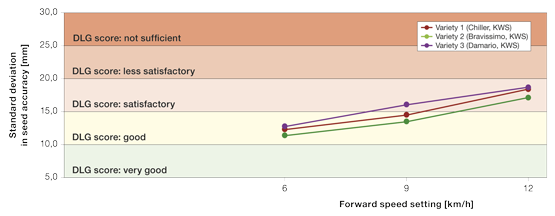
Figure 4 shows the computed standard deviations as determined for the various forward speeds. The diagram shows that the following tendency was found in all three varieties: the standard deviation increases when forward speed increases. This means that the seed spacings become less uniform. The standard deviation of Bravissimo variety (big round seeds) was not as large compared with Damario (tooth shaped seed), which translates into more uniform spacings.
Table 3 shows the percentages for target spacings, doubles and gaps. In all tests the percentage of doubles was between 0 % and 0.1 % (very low). In all tests the percentage of gaps was between 0 % and 0.3 % (very low). The percentages of gaps in Chiller (small round kernels) were lower than those of the other two varieties. The percentages of target spacings were between 99.6 % and 100 %. This applies to all lab test runs at all forward speeds and all varieties.
In addition, all three varieties were lab tested also at 15 km/h. In these tests, the sowing unit was found to produce a standard deviation of 21.24 mm, 0 % of doubles and 0.2 % of gaps when drilling Chiller. Drilling Bravissimo, the standard deviation was 20.83 mm, the percentage of doubles was 0 % and that of gaps 0.2 %. For Damario, the standard deviation was 22.87 mm, the percentage of doubles 0.1 % and the percentage of gaps 0.4 %.
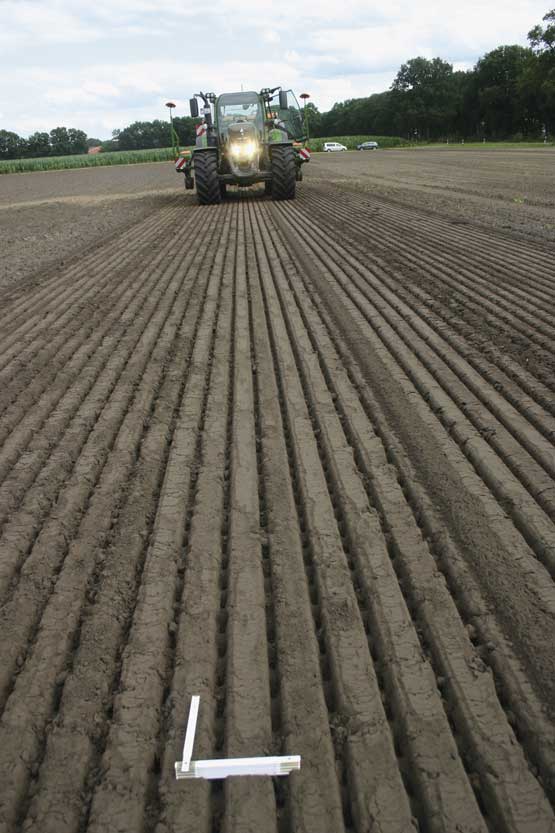
The field test
Accuracy of eventual crop spacing, distribution and field emergence
The soil in the test field is sandy humus (22 soil value points). After a crop of winter barley was harvested on 17 July 2020 (yielding 6810.00 kg/ha, straw harvested), the field was cultivated by an Amazone Catros 7003-2TX disc harrow at a depth of 3 cm on 20 July 2020. On 24 July 2020, the test field received a 20 cm deep ploughing pass by an Amazone Cayron 200 VS with press. On 29 July 2020, the field was cultivated 6 cm deep by an Amazone KG 3001 rotary cultivator i mmediately before drilling the maize. The seedbed was described as sufficiently consolidated (Figure 5).
The following three maize varieties were drilled on 29 July 2020:
- Chiller (KWS), 255 g thousand grain weight, 95 % ability of germination as per LUFA lab analysis
- Bravissimo (KWS), 358 g thousand grain weight, 96 % ability of germination as per LUFA lab analysis
- Damario (KWS), 351 g thousand grain weight, 98 % ability of germination as per LUFA lab analysis
The varieties were sown at the following forward speeds: 6 km/h, 9 km/h and 12 km/h. Afterwards, the testers randomly sampled the seed rows to verify the accuracy of seed placement. Figure 6 shows an example of seed placement of Bravissimo at 12 km/h.
There was no rainfall between 29 July 2020 (the date of drilling) and 11 August 2020, the date on which the crop spacings were evaluated. Although soil moisture levels were low on the day of seeding (12.9 %), it was found that thanks to capillary action the seeds had adequate access to moisture for germination. Amazone says, this is also attributed to the technical details of the sowing unit (for example, to the interaction of the furrow former and the catcher roller).
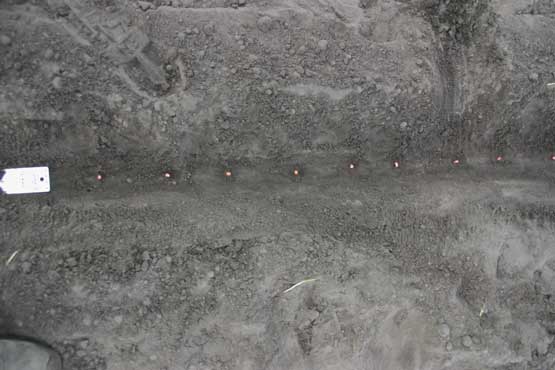
On 11 August 2020, the testers measured the spacings between the emerged crops. These results are shown in table 4. Field emergence is always assessed as ‘very good’ in all test variants. This ranged between 94.5 % and 98.0 %, which is identical with the ability to germinate for the crops.
The accuracy of eventual spacing of all varieties by forward speed and variety is assessed as ‘very good’ and ‘good’ with one exemption.
All standard deviations in eventual crop spacing in the field as related to the forward speed are shown in figure 7. This graph reflects the same trend for the field test as for the lab test: The crop spacings become less uniform as the work rate increases. At 6 km/h and 9 km/h, the accuracy of eventual crop spacing is ‘very good’ without exception.
Table 4: The test results on accuracy of eventual crop spacing, distribution and emergence (field test)
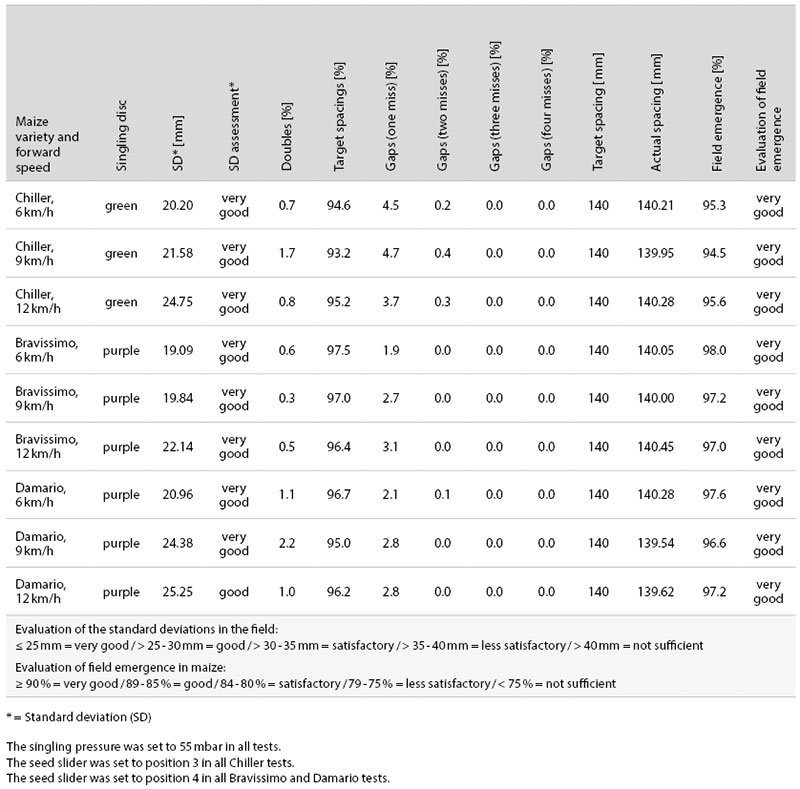
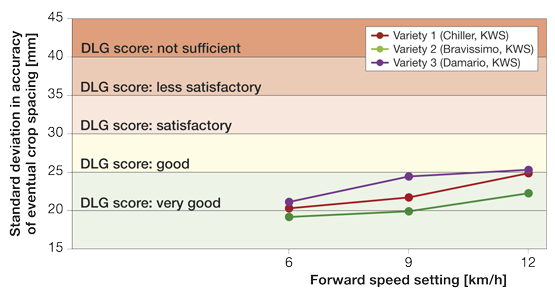
At 12 km/h, the accuracy of eventual crop spacing by variety is ‘very good’ and ‘good’.
The percentages of target spacings were 93.2 % and 97.5 % in the test. (The percentages of doubles and gaps in the field are never assessed in a DLG field test.) The percentages of doubles in this test were between 0.3 % and 2.2 %. The percentages of gaps were 1.9 % and 5.1 % across all test runs (table 4). The Bravissimo and Damario maize varieties show that the percentages of gaps increased as forward speed increased.
The evaluation of the crop spacings on 11 August 2020 produced 45 gaps in the test field. These 45 gaps were uniformly distributed across all 9 varieties. In 40 out of these 45 gaps it was found that the individual seeds had been placed properly (89 %). The Amazone sowing unit had placed it accurately in the correct spot. The seeds uncovered in the gaps were found to have germinated but had ceased growing due to lack of water. Yet, no seeds were found in the other five gaps (out of 45) (11 %).
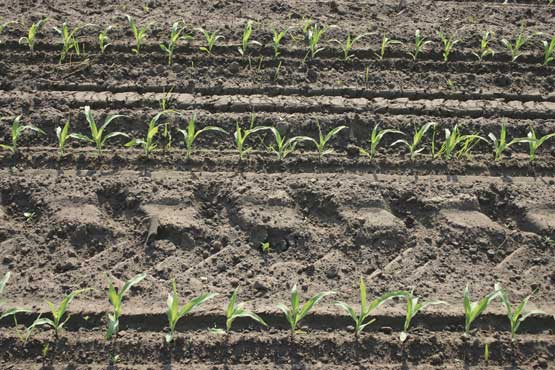
Figure 8 shows the young plants on 11 August 2020 (Bravissimo drilled at 12 km/h). All three maize varieties were also field tested at a work rate of 15 km/h. In these tests, the standard deviation was 27.26 mm, the percentage of doubles 0.7 %, that of gaps 4.8 % and the emergence rate was 95.4 % for Chiller. For Bravissimo, the standard deviation was 25.51 mm, the percentage of doubles was 1.0 %, the percentage of gaps 3.7 % and the emergence rate was 95.8 %. For Damario, the standard deviation was 28.55 mm, the percentage of doubles 2.6 % and the percentage of gaps 3.8 % and the field emergence rate was 95.9 %.
Summary
In the field test, the Amazone PreTeC sowing unit achieved a ‘very good’ and ‘good’ accuracy in eventual crop spacing by maize variety even when drilling at work rates of 12 km/h. Field emergence is always assessed as ‘very good’ in all test variants. These ranged between 94.5 % and 98.0 %, which equates the ability to germinate of this crop. The percentages of target spacings were between 93.2 % and 97.5 %. The percentages of double were between 0.3 % and 2.2 %. The percentages of gaps were between 1.9 % and 5.1 %.
In the lab tests, the percentages of doubles and gaps were found to be “very small”. Based on these test results, the Amazone PreTeC sowing unit is awarded the DLG APPROVED quality mark in the 2020 partial test “Working quality in maize” for work rates of up to 12 km/h.
Manufacturer and applicant
Manufacturer and applicantr
Manufacturer and applicant
Amazonen-Werke H. Dreyer GmbH & Co. KG
Am Amazonenwerk 9-13, 49205 Hasbergen-Gaste,
Germany
Test performed by
Testing agency
DLG TestService GmbH, Gross-Umstadt location
The tests are conducted on behalf of DLG e.V.
DLG test framework
Precision drills (date of issue 04/2016)
Department
Agriculture
Head of Department
Dr. Ulrich Rubenschuh
Test engineer(s)
Dipl.-Ing agr.
Georg Horst Schuchmann*
* Author
Contact
DLG TestService GmbH - Groß-Umstadt location • Max-Eyth-Weg 1 64823 Groß-Umstadt Germany • Tel.: +49(0)69 24 788-611 • tech@DLG.org

